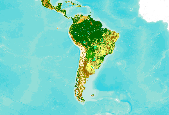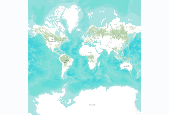|
|

Las plantas monocotiledóneas que vuelan de América del Sur, América Central y el Caribe (monocots)

Las Algas (Algae) de América del Sur, América Central y el Caribe .

This dataset shows innundation from the terrestrial ecosystems (reference classification) of South America, Central America, and Mexico. South America: This dataset represents Ecological System patches using various reference datasets. Original data generarated from 2000 era data, modeled in 2005 and updated in 2008 and 2010.Originally, this project developed a GIS modeling approach, using a variety of abiotic and biotic data sets, to produce a map of the distribution of Latin America and Caribbean (LAC) ecological systems throughout South America for use in ecoregional assessments. Ecological systems, defined as spatially co-occuring assemblages of vegetation types sharing a common underlying substrate, ecological...

This dataset was extracted from the terrestrial ecosystems of South America dataset. South America: This dataset represents Ecological System patches using various reference datasets. Original data generarated from 2000 era data, modeled in 2005 and updated in 2008 and 2010.Originally, this project developed a GIS modeling approach, using a variety of abiotic and biotic data sets, to produce a map of the distribution of Latin America and Caribbean (LAC) ecological systems throughout South America for use in ecoregional assessments. Ecological systems, defined as spatially co-occuring assemblages of vegetation types sharing a common underlying substrate, ecological process, or gradient, were identified for all...

Las especies invasoras de América del Sur, América Central y el Caribe (invasive species).

The Digital Chart of the World (DCW) is an Environmental Systems Research Institute, Inc. (ESRI) product originally developed for the US Defense Mapping Agency (DMA) using DMA data. The DCW 1993 version at 1:1,000,000 scale was used. The DMA data sources are aeronautical charts, which emphasize landmarks important from flying altitudes. This explains why there is a separate aeronautical theme with all conceivable airports, yet why on some themes small islands and lakes are simply unnamed points. ESRI, in compiling the DCW, also eliminated some detail and made some assumptions for handling tiny polygons and edgematching. Also, note that the completeness of the thematic categories present in each layer will vary....

The Digital Chart of the World (DCW) is an Environmental Systems Research Institute, Inc. (ESRI) product originally developed for the US Defense Mapping Agency (DMA) using DMA data. The DCW 1993 version at 1:1,000,000 scale was used. The DMA data sources are aeronautical charts, which emphasize landmarks important from flying altitudes. This explains why there is a separate aeronautical theme with all conceivable airports, yet why on some themes small islands and lakes are simply unnamed points. ESRI, in compiling the DCW, also eliminated some detail and made some assumptions for handling tiny polygons and edgematching. Also, note that the completeness of the thematic categories present in each layer will vary....

This dataset is an extract from the GlobCover 2009 land cover map, covering Central and South America. The GlobCover 2009 land cover map is derived by an automatic and regionally-tuned classification of a time series of global MERIS (MEdium Resolution Imaging Spectrometer) FR mosaics for the year 2009. The global land cover map counts 22 land cover classes defined with the United Nations (UN) Land Cover Classification System (LCCS). For more information on the GlobCover project, see http://ionia1.esrin.esa.int/ Note on display: class 210: Water Bodies is set to "transparent" to improve display in the Data Basin map. Within the extract's extent, no data were removed from the original dataset.

Las especies invasoras de América del Sur, América Central y el Caribe (invasive species).

The Digital Chart of the World (DCW) is an Environmental Systems Research Institute, Inc. (ESRI) product originally developed for the US Defense Mapping Agency (DMA) using DMA data. The DCW 1993 version at 1:1,000,000 scale was used. The DMA data sources are aeronautical charts, which emphasize landmarks important from flying altitudes. This explains why there is a separate aeronautical theme with all conceivable airports, yet why on some themes small islands and lakes are simply unnamed points. ESRI, in compiling the DCW, also eliminated some detail and made some assumptions for handling tiny polygons and edgematching. Also, note that the completeness of the thematic categories present in each layer will vary....

The Digital Chart of the World (DCW) is an Environmental Systems Research Institute, Inc. (ESRI) product originally developed for the US Defense Mapping Agency (DMA) using DMA data. The DCW 1993 version at 1:1,000,000 scale was used. The DMA data sources are aeronautical charts, which emphasize landmarks important from flying altitudes. This explains why there is a separate aeronautical theme with all conceivable airports, yet why on some themes small islands and lakes are simply unnamed points. ESRI, in compiling the DCW, also eliminated some detail and made some assumptions for handling tiny polygons and edgematching. Also, note that the completeness of the thematic categories present in each layer will vary....

Aves de América del Sur, América Central y el Caribe (Birds).

Las Algas (Algae) de América del Sur, América Central y el Caribe .

This dataset was extracted from the terrestrial ecosystems of South America dataset. South America: This dataset represents Ecological System patches using various reference datasets. Original data generarated from 2000 era data, modeled in 2005 and updated in 2008 and 2010.Originally, this project developed a GIS modeling approach, using a variety of abiotic and biotic data sets, to produce a map of the distribution of Latin America and Caribbean (LAC) ecological systems throughout South America for use in ecoregional assessments. Ecological systems, defined as spatially co-occuring assemblages of vegetation types sharing a common underlying substrate, ecological process, or gradient, were identified for all...

Pez de América del Sur, América Central y el Caribe (fish)

Los otros Artrópodos de América del Sur, América Central y el Caribe (other arthropods)

Las plantas gimnospermas de América del Sur, América Central y el Caribe l (gymnosperms).

Las especies invasoras de América del Sur, América Central y el Caribe (invasive species).

This dataset shows landcover from the terrestrial ecosystems (reference classification) of South America, Central America, and Mexico. South America: This dataset represents Ecological System patches using various reference datasets. Original data generarated from 2000 era data, modeled in 2005 and updated in 2008 and 2010.Originally, this project developed a GIS modeling approach, using a variety of abiotic and biotic data sets, to produce a map of the distribution of Latin America and Caribbean (LAC) ecological systems throughout South America for use in ecoregional assessments. Ecological systems, defined as spatially co-occuring assemblages of vegetation types sharing a common underlying substrate, ecological...

This dataset shows bioclimate from the terrestrial ecosystems (reference classification) of South America, Central America, and Mexico. South America: This dataset represents Ecological System patches using various reference datasets. Original data generarated from 2000 era data, modeled in 2005 and updated in 2008 and 2010.Originally, this project developed a GIS modeling approach, using a variety of abiotic and biotic data sets, to produce a map of the distribution of Latin America and Caribbean (LAC) ecological systems throughout South America for use in ecoregional assessments. Ecological systems, defined as spatially co-occuring assemblages of vegetation types sharing a common underlying substrate, ecological...
|
|